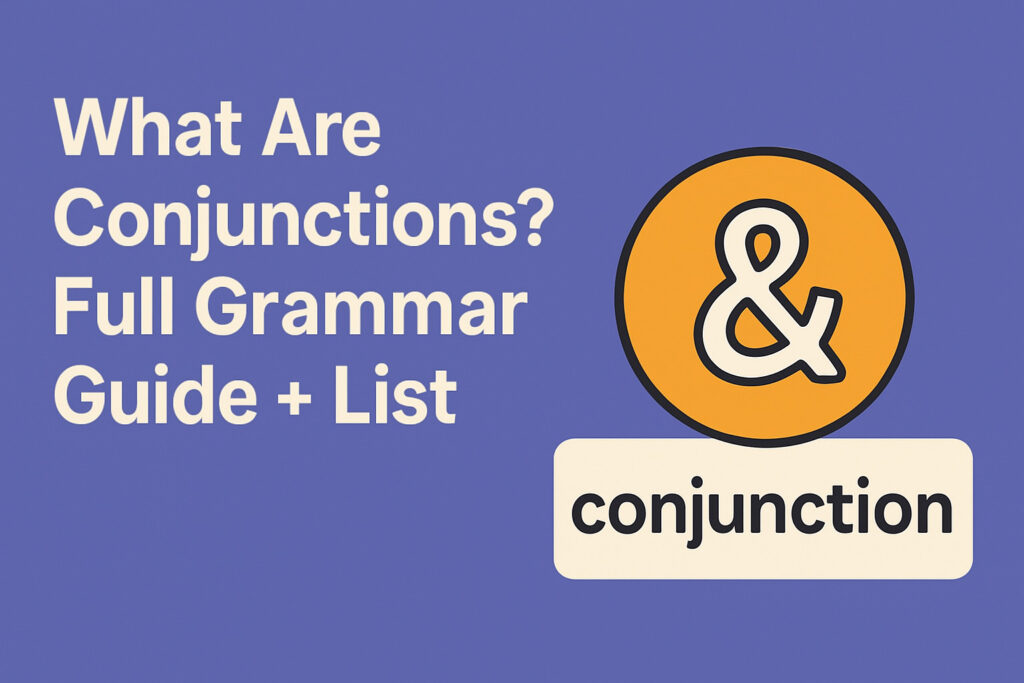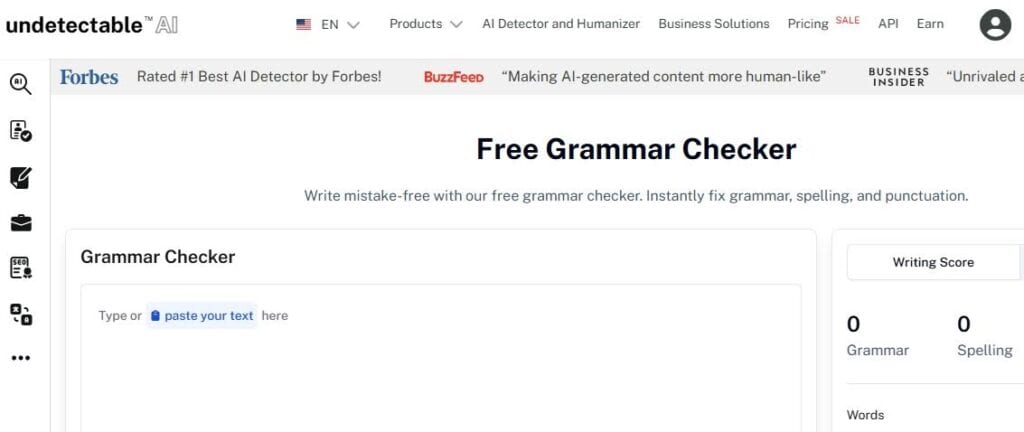A couple of months back, I was helping my little cousin with his homework when he looked up from his grammar worksheet and asked, “What’s a conjunction again?”
I opened my mouth to answer…and froze. I knew what a conjunction felt like. I use them every day.
But suddenly, trying to explain it in simple words felt way harder than it should have been.
We all use conjunctions daily (even without thinking).
But when it comes time to explain them or use them correctly, it suddenly feels like you hit a wall.
What do they really do? When do you need a comma?
Why do some sentences sound wrong, even when they’re technically right?
This blog breaks it all down.
Key Takeaways
- Conjunctions are words that connect ideas. They make your writing smoother and easier to follow.
- There are three main types of conjunctions: coordinating, subordinating, and correlative.
- Using the wrong conjunction can make your sentence confusing.
- To use conjunctions well, focus on what you’re trying to connect, i.e., equal parts, dependent ideas, or matched pairs.
What Is a Conjunction?

Explaining what are conjunctions isn’t as easy as describing a noun, but let me try to do a better job here than I did trying to explain it to my cousin.
A conjunction is a word that connects.
That’s it. It links words, phrases, or whole sentences together so your writing does not feel awkward or choppy.


Never Worry About AI Detecting Your Texts Again. Undetectable AI Can Help You:
- Make your AI assisted writing appear human-like.
- Bypass all major AI detection tools with just one click.
- Use AI safely and confidently in school and work.
Here’s a quick example:
- Without a conjunction: I was tired. I kept working.
- With a conjunction: I was tired, but I kept working.
See the difference? It’s barely noticeable, but adding one tiny word changed the whole rhythm of the sentence.
It helped show the relationship between the two ideas.
Types of Conjunctions
You’d think all conjunctions do the same job, but that’s not the truth.
Some connect equal words, while others connect ideas that depend on each other.
A few of them, on the other hand, work in pairs.
The following breakdown will help you make sense of it:
1. What Are Coordinating Conjunctions?
These are the most common ones and the easiest to use. Coordinating conjunctions connect words, phrases, or independent clauses that are grammatically equal.
Think peanut butter and jelly. They go side by side, don’t they?
There are only seven of them, and you can remember them with the acronym FANBOYS:
- For
- And
- Nor
- But
- Or
- Yet
- So
Example:
- I am dressing up, so I can go out for a walk.
- You can have tea or coffee.
2. What Are the Subordinating Conjunctions?
Subordinating conjunctions connect two ideas, but one depends on the other.
They usually introduce a dependent clause (an incomplete thought) and attach it to an independent clause (a complete sentence).
Complicated, huh? Not really.
In simple words, they show cause, time, condition, contrast, or reason. They answer questions like Why? When? Under what condition?
Common subordinating conjunctions include:
- Because
- Although
- Since
- While
- After
- Before
- Unless
- If
- Even though
- When
If you’ve ever asked yourself what are the subordinating conjunctions, now you know!
They’re the glue that connects ideas when one thought relies on the other to make sense.
3. What Are Correlative Conjunctions?
These work in pairs. You use correlative conjunctions when you want to link balanced ideas in a sentence.
Examples include:
- either… or
- neither… nor
- both… and
- not only… but also (AI models love this one too much 😉)
Example:
- Either we leave now, or we miss the train.
- She’s not only smart, but also incredibly kind.
They add a nice rhythm to your writing when used right. But there’s a small catch to it.
If you don’t keep the structure balanced on both sides, they lose their charm.
Now I don’t expect you to get the hang of it instantly, especially if you’re a student.
Lucky for you, I have something that might help.
This Ask AI tool by Undetectable AI can help you with your homework on conjunctions.
For instance, you could ask it to explain what are subordinating conjunctions and how to use them. It will provide you with a detailed explanation of the topic.

Rules for Using Conjunctions
Conjunctions often just slip into our sentences.
More often than not, we don’t even realize they are the culprit behind our sentences feeling a little off.
But that stops now. The next time you start writing, make sure you remember these rules:
- Use a Comma Before a Coordinating Conjunction (Sometimes)
If you’re joining two complete sentences (also called independent clauses) with a coordinating conjunction “like and, but, or so,” you usually need a comma before the conjunction.
Correct: I wanted to go to the beach, but it started raining.
Wrong: I wanted to go to the beach but it started raining. (Missing comma)
However, if you’re only joining two words or short phrases, no comma is needed.
- Don’t Use Too Many Conjunctions in One Sentence
Trying to link too many ideas together with conjunctions can make your sentence confusing or messy.
Example: I wanted to go for a walk and I was tired but I needed air so I still went and then I saw my friend.
Notice how messy that sounds? When you’ve more to say, you should break long sentences into shorter ones. Let me demonstrate what a better version of the complex sentence above would look like.
I was tired, but I needed air. So, I went for a walk and ran into a friend.
- Keep Sentence Structure Parallel with Correlative Conjunctions
When using correlative conjunctions like either…or or not only…but also, both parts of the sentence should follow the same grammatical structure.
The sentence, ‘She is not only smart but also works hard,’ feels a bit awkward. Why? Because you’ve got to match nouns with nouns, verbs with verbs, and so on.
The correct version would read: She is not only smart but also hardworking.
- Subordinating Conjunctions Create Dependent Clauses
A subordinating conjunction (because, although, since, if) makes a sentence dependent. This means the sentence can’t stand alone.
Wrong: Because I was tired. (This is incomplete)
Correct: I went to bed because I was tired.
It doesn’t matter if you place the dependent clause at the beginning or the end as long as your full sentence is complete.
- Avoid Double Conjunctions (Unless Intentional)
Sometimes we accidentally stack conjunctions out of habit, especially when we’re speaking informally. In writing, it can make your sentence clunky.
Example: Although she was tired, but she still went out.
Correct: She was tired, but she still went out.
- Use Conjunctions to Show Clear Relationships Between Ideas
Each conjunction has a particular purpose. Always pick the one that clearly shows what you mean.
- Use and to add information
- Use but/yet to show contrast
- Use so to show cause and effect
- Use because to give reasons
- Use although/though to show unexpected contrast
- Use or to present choices
Now, all these rules will not come naturally to you. It will take time and practice. Meanwhile, you can use Undetectable AI’s Grammar Checker to fix any conjunction mistakes in your writing.

Examples of Conjunctions in Use
Okay, so you get the idea of what conjunctions are. Now, let’s see how they are actually used in sentences.
Coordinating Conjunctions
- She brought snacks and drinks for the trip.
- He didn’t call, nor did he text.
- I was full, yet I still had dessert.
- It was late, so we called it a night.
Subordinating Conjunctions
- I stayed home because I wasn’t feeling great.
- Although she was nervous, she gave a great presentation.
- I’ll call you when I get there.
- If it rains tomorrow, we’ll cancel the picnic.
Correlative Conjunctions
- She’s not only funny, but also thoughtful.
- You can either join us now or meet us there.
- Neither the lights nor the AC was working.
- Both the manager and the staff agreed.
Common Mistakes and How to Fix Them

Conjunctions are not as much of a headache as long as you don’t make the following mistakes:
1. Starting a Sentence with a Conjunction
You can absolutely start your sentence with a conjunction. It’s not a crime.
If starting with a conjunction makes your sentence more natural or dramatic, go for it. Just don’t overdo it.
2. Sentence Fragments After Subordinating Conjunctions
When you start a sentence with a subordinating conjunction but do not finish the thought, you mess up. It leaves the reader hanging.
The sentence, ‘Although it was raining,’ feels incomplete. But ‘Although it was raining, we still went hiking’ feels complete.
3. Mixing Up Correlative Conjunctions
Using one half of the pair but not the other, or creating a mismatched structure, is another common mistake.
Always use the full pair (not only…but also, either…or, neither…nor) and keep both sides balanced.
4. Too Many Ideas in One Sentence
Never put 4 or 5 ideas into a sentence just because conjunctions can connect things. Break it up. Use conjunctions to guide the reader. Do not use them to overwhelm the readers.
Personally, I always turn to the AI Humanizer by Undetectable AI when I can’t figure out the correct usage of conjunctions.

No, this tool isn’t only for bypassing AI-content detection.
It can even rephrase human-written content to make it sound more natural, flow better, and have a proper structure.
How to Choose the Right Conjunction
Truth be told, most of the time, your intuition already knows which conjunction fits.
The trick is asking yourself one question:
“What am I trying to connect here?”
- Two similar ideas? Use a smooth linker.
- A contrast? Pick something that signals a turn.
- A reason or result? Go with a cause-and-effect bridge.
You don’t need to memorize a hundred rules. All you need to do is listen to your sentence. If it feels off, the conjunction might be wrong (or maybe you don’t need one at all).
Practice Exercises
Understanding what are coordinating conjunctions or subordinating conjunctions is one thing. But being able to use them confidently is another.
These quick exercises will test your understanding:
Fill in the Blanks
Choose the correct conjunction to complete each sentence:
- I wanted to stay home, ______ I had already made plans.
- We missed the bus ______ we left the house late.
Rewrite the Sentences
Combine these short sentences using appropriate conjunctions:
- I was tired. I finished my homework.
- He likes dogs. He doesn’t like cats.
- We ordered food. We watched a movie.
You can also check out these printable worksheets to further put your knowledge to test.
Start optimizing your content—use our AI Detector and Humanizer below.
Final Thoughts
M&M has quite an iconic tagline, i.e., “Melts in your mouth, not in your hands.”
But what if it used the wrong conjunction instead? What if it said “Melts in your mouth or in your hands”?
Suddenly, no one’s reaching for a handful. That’s the power of a single conjunction. One tiny word can sharpen a message or sabotage it.
So the next time you write, make sure you are using your conjunctions accurately and appropriately!
Want to be sure your conjunctions are doing their job?
Use Undetectable AI to review your writing for clarity, flow, and the kind of polish that keeps your message strong.
